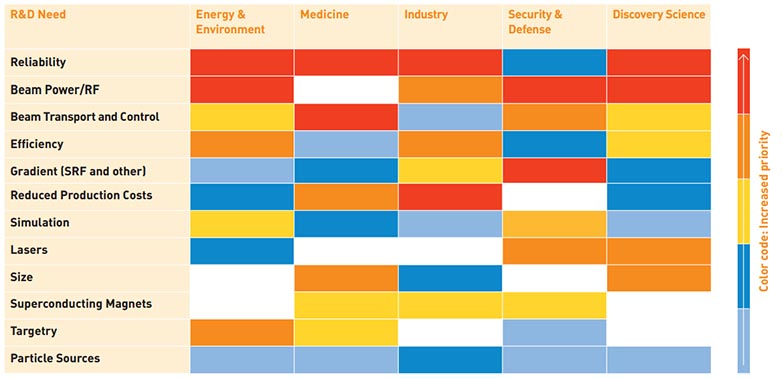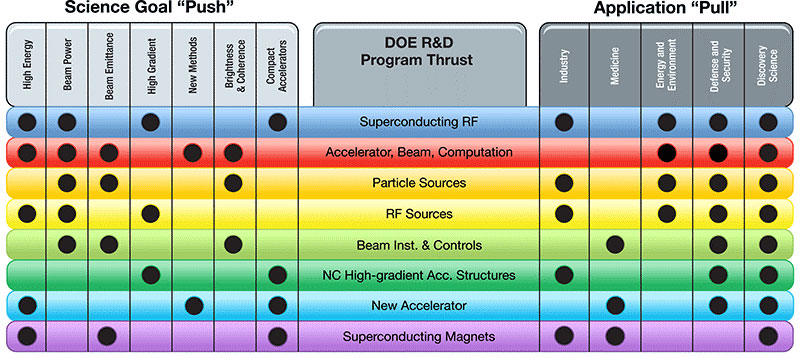Background
Areas of R&D identified by Accelerators for America’s Future working groups. Color coding indicates importance, red being most important.
Accelerators for America’s Future Workshop
In October 2009, HEP sponsored a symposium and workshop entitled “Accelerators for America’s Future” Co-chaired by Drs. Walter Henning and Charles Shank. The purpose of the meeting was to elicit the views and opinions of a wide range of accelerator users on the challenges and opportunities for developing and deploying accelerators to meet national needs. About 300 people attended the symposium and poster session that took place on the first day. The next two days involved 120 users of accelerator technology—ranging from small business owners to well-known accelerator researchers—who were specially invited to give their perspective on needs, challenges, and areas of greatest promise, and to provide guidance on how to transform the accelerator research into actual hardware deployment. The comprehensive Summary Report from this workshop served as the starting point in the accelerator R&D stewardship planning process.
It was recognized by the workshop participants that taking advantage of the opportunities identified would require coordinated, sustained R&D progress in a number of technical areas. Some desired features of accelerators were common across many of the working groups, as illustrated in the figure above, taken from the workshop report. In particular, reduced accelerator cost and size, and improved reliability and efficiency, were broadly important.
Connections between science goals and technology applications for DOE R&D thrust areas, as identified in the Accelerator R&D Task Force report.
Accelerator R&D Task Force
To prepare for creating an accelerator R&D stewardship strategic plan, Dr. Jim Siegrist, Associate Director of Science for High Energy Physics, in consultation with other SC Associate Directors, asked SLAC National Accelerator Laboratory to convene a community task force, chaired by Dr. Norbert Holtkamp from SLAC, to provide information that would
- Identify research opportunities that might have strong potential for broad national benefits;
- Summarize the status of key research and technology areas identified; and
- Identify possible impediments (both technical and otherwise) to successful accelerator R&D stewardship activities for the broad user base envisioned.
The Accelerator R&D Task Force consisted of members from national laboratories, universities, and industries who had expertise in one or more of the subject areas identified in the Accelerators for America’s Future workshop. This group of people met several times during the period from December 2011 to February 2012, carried out their own investigations to update, as needed, the earlier workshop findings, and heard presentations from various experts on topics of relevance to their task. The Task Force also set up a blog to solicit input from the broader accelerator community, and advertised its existence widely. In the end, they produced a report summarizing the information obtained by the individual members.
Community Input and Future Program Planning
To date, three workshops, two requests for information, and a National Academies Study have been sponsored or co-sponsored by DOE’s Office of High Energy Physics to identify the highest impact applications of accelerator technology and the basic research needed to advance. The workshops—the Ion Beam Therapy Workshop, the Workshop on Laser Technology for Accelerators, and the Workshop on Energy and Environmental Applications of Accelerators, have brought together both the users and designers of accelerator technology to discuss the challenges and next steps needed to make transformative advances. The RFIs have served a preparatory role, gathering information about Energy & Environmental applications of accelerators, and about strategies to strengthen U.S. academic accelerator science. The NAS study is expected to develop the science case for a new class of laser science in the United States, and will be published in early 2017.
As the Stewardship program grows and evolves, future years will see additional workshops and funded studies to define applied R&D topics in security, defense, industrial, and other applications of accelerators, and to assess progress and direction of funded topics.






